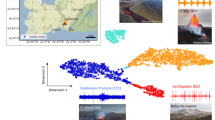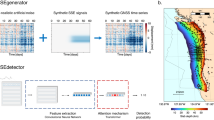Abstract
Tectonic faults slip in various manners, which range from ordinary earthquakes to slow slip events to aseismic fault creep. Slow slip and associated tremor are common to many subduction zones, and occur down-dip from the neighbouring locked zone where megaquakes take place. In the clearest cases, such as Cascadia, identified tremor occurs in discrete bursts, primarily during the slow slip event. Here we show that the Cascadia subduction zone is apparently continuously broadcasting a low-amplitude, tremor-like signal that precisely informs of the fault displacement rate throughout the slow slip cycle. Using a method based on machine learning previously developed in the laboratory, we analysed large amounts of raw seismic data from Vancouver Island to separate this signal from the background seismic noise. We posit that this provides indirect real-time access to fault physics on the down-dip portion of the megathrust, and thus may prove useful in determining if and how a slow slip may couple to or evolve into a major earthquake.
This is a preview of subscription content, access via your institution
Access options
Access Nature and 54 other Nature Portfolio journals
Get Nature+, our best-value online-access subscription
$29.99 / 30 days
cancel any time
Subscribe to this journal
Receive 12 print issues and online access
$259.00 per year
only $21.58 per issue
Buy this article
- Purchase on Springer Link
- Instant access to full article PDF
Prices may be subject to local taxes which are calculated during checkout



Similar content being viewed by others

Data availability
All the data used are publicly available and can be found online. The seismic data are from the CNSN27 (www.earthquakescanada.nrcan.gc.ca), and the GPS data are from the Western Canada Deformation Array operated by the Geological Survey of Canada, preprocessed by the United States Geological Survey28 (https://earthquake.usgs.gov/monitoring/gps/Pacific_Northwest, NA-fixed trended data). The work flow described in Methods uses open source software (python and python packages including scikit-learn37 and obspy36). We are currently unable to make the python script associated with this paper available, but we aim to make it available in the near future. Please contact bertrandrl@lanl.gov for details.
References
Obara, K. Nonvolcanic deep tremor associated with subduction in southwest Japan. Science 296, 1679–1681 (2002).
Rogers, G. & Dragert, H. Episodic tremor and slip on the Cascadia subduction zone: the chatter of silent slip. Science 300, 1942–1943 (2003).
Perfettini, H. et al. Seismic and aseismic slip on the Central Peru megathrust. Nature 465, 78–81 (2010).
Wech, A. G., Creager, K. C. & Melbourne, T. I. Seismic and geodetic constraints on Cascadia slow slip. J. Geophys. Res. Solid Earth 114, B10316 (2009).
Bartlow, N. M., Miyazaki, S., Bradley, A. M. & Segall, P. Space–time correlation of slip and tremor during the 2009 Cascadia slow slip event. Geophys. Res. Lett. 38, L18309 (2011).
Kao, H. et al. Spatial–temporal patterns of seismic tremors in northern Cascadia. J. Geophys. Res. Solid Earth 111, B03309 (2006).
Kao, H., Shan, S.-J., Dragert, H. & Rogers, G. Northern Cascadia episodic tremor and slip: a decade of tremor observations from 1997 to 2007. J. Geophys. Res. Solid Earth 114, B00A12 (2009).
Wech, A. G. & Creager, K. C. Automated detection and location of Cascadia tremor. Geophys. Res. Lett. 35, L20302 (2008).
Wang, K., Hu, Y. & He, J. Deformation cycles of subduction earthquakes in a viscoelastic earth. Nature 484, 327–332 (2012).
Goldfinger, C., Nelson, C. H., Johnson, J. E. & Party, T. S. S. Holocene earthquake records from the Cascadia subduction zone and northern San Andreas fault based on precise dating of offshore turbidites. Ann. Rev. Earth Planet. Sci. 31, 555–577 (2003).
Wech, A. G. & Bartlow, N. M. Slip rate and tremor genesis in Cascadia. Geophys. Res. Lett. 41, 392–398 (2014).
Frank, W. B. Slow slip hidden in the noise: the intermittence of tectonic release. Geophys. Res. Lett. 43, 125–10,133 (2016).
Hawthorne, C. J. & Rubin, A. M. Short-time scale correlation between slow slip and tremor in Cascadia. J. Geophys. Res. Solid Earth 118, 1316–1329 (2013).
Brace, W. F. & Byerlee, J. D. Stick–slip as a mechanism for earthquakes. Science 153, 990–992 (1966).
Scholz, C. H. The Mechanics of Earthquakes and Faulting (Cambridge Univ. Press, Cambridge, 2002).
Obara, K. & Kato, A. Connecting slow earthquakes to huge earthquakes. Science 353, 253–257 (2016).
Satake, K., Shimazaki, K., Tsuji, Y. & Ueda, K. Time and size of a giant earthquake in Cascadia inferred from Japanese tsunami records of January 1700. Nature 379, 246–249 (1996).
Aguiar, A. C., Melbourne, T. I. & Scrivner, C. W. Moment release rate of Cascadia tremor constrained by GPS. J. Geophys. Res. Solid Earth 114, B00A05 (2009).
Ito, Y. et al. Episodic slow slip events in the Japan subduction zone before the 2011 Tohoku-Oki earthquake. Tectonophysics 600, 14–26 (2013).
Hasegawa, A. & Yoshida, K. Preceding seismic activity and slow slip events in the source area of the 2011 Mw 9.0 Tohoku-Oki earthquake: a review. Geosci. Lett. 2, 6 (2015).
Kato, A. et al. Propagation of slow slip leading up to the 2011 Mw 9.0 Tohoku-Oki Earthquake. Science 335, 705–708 (2012).
Radiguet, M. et al. Triggering of the 2014 Mw 7.3 Papanoa earthquake by a slow slip event in Guerrero, Mexico. Nat. Geosci. 9, 829–834 (2016).
Ruiz, S. et al. Intense foreshocks and a slow slip event preceded the 2014 Iquique Mw 8.1 earthquake. Science 345, 1165–1169 (2014).
Kostoglodov, V. et al. The 2006 slow slip event and nonvolcanic tremor in the Mexican subduction zone. Geophys. Res. Lett. 37, L24301 (2010).
Rouet-Leduc, B. et al. Estimating fault friction from seismic signals in the laboratory. Geophys. Res. Lett. 45, 1321–1329 (2018).
Hulbert, C. et al. Laboratory earthquake prediction illuminates connections between the spectrum of fault slip modes. Nat. Geosci. https://doi.org/10.1038/s41561-018-0272-8 (2018).
IRIS DMC FDSNWS Dataselect Web Service (IRIS, Geological Survey of Canada, accessed 1 September 2017); http://service.iris.edu/fdsnws/dataselect/1/
Murray, J. R. & Svarc, J. Global positioning system data collection, processing, and analysis conducted by the US Geological Survey Earthquake Hazards Program. Seismol. Res. Lett. 88, 916–925 (2017).
Gripp, A. E. & Gordon, R. G. Young tracks of hotspots and current plate velocities. Geophys. J. Int, 150, 321–361 (2002).
Xue, M. & Allen, R. M. The fate of the Juan de Fuca plate: implications for a Yellowstone plume head. Earth Planet. Sci. Lett. 264, 266–276 (2007).
Zhang, J. et al. Cascadia tremor spectra: low corner frequencies and earthquake-like high-frequency falloff. Geochem. Geophys. Geosyst. 12, Q10007 (2011).
Bensen, G. et al. Processing seismic ambient noise data to obtain reliable broad-band surface wave dispersion measurements. Geophys. J. Int. 169, 1239–1260 (2007).
Breiman, L. Random forests. Machine Learning 45, 5–32 (2001).
Holtkamp, S. & Brudzinski, M. Determination of slow slip episodes and strain accumulation along the Cascadia margin. J. Geophys. Res. Solid Earth 115, B00A17 (2007).
Rouet-Leduc, B. et al. Machine learning predicts laboratory earthquakes. Geophys. Res. Lett. 44, 9276–9282 (2017).
Beyreuther, M. et al. Obspy: a python toolbox for seismology. Seismol. Res. Lett. 81, 530–533 (2010).
Pedregosa, F. et al. Scikit-learn: machine learning in python. J. Machine Learning Res. 12, 2825–2830 (2011).
Gregorutti, B., Michel, B. & Saint-Pierre, P. Correlation and variable importance in random forests. Stat. Comput. 27, 659–678 (2017).
Breiman, L., Friedman, J. H., Olshen, R. A. & Stone, C. J. Classification and Regression Trees (CRC Press, New York, 1999).
Jones, D. R., Schonlau, M. & Welch, W. J. Efficient global optimization of expensive black-box functions. J. Global Optim. 13, 455–492 (1998).
Acknowledgements
This work was funded by Institutional Support (LDRD) at Los Alamos and the DOE Office of Basic Research, Geoscience Program. We are grateful to H. Dragert, H. Kao, T. Melbourne, J. Gomberg, D. Trugman, R. Guyer, A. Delorey, J. Murray, I. McBrearty and C. Lee for fruitful comments and discussions. We thank W. Frank for his extensive review of our work and his suggestions. We thank T. Cote, X. Jin and M. Kolaj from the CNSN for their data and help.
Author information
Authors and Affiliations
Contributions
All the authors devised the original study. B.R.L. and C.H. conducted the machine-learning work and all the authors contributed to writing the manuscript.
Corresponding author
Ethics declarations
Competing interests
The authors declare no competing interests.
Additional information
Publisher’s note: Springer Nature remains neutral with regard to jurisdictional claims in published maps and institutional affiliations.
Supplementary information
Supplementary Information
Further information on machine learning and GPS displacement and Supplementary Figures 1–6.
Rights and permissions
About this article
Cite this article
Rouet-Leduc, B., Hulbert, C. & Johnson, P.A. Continuous chatter of the Cascadia subduction zone revealed by machine learning. Nature Geosci 12, 75–79 (2019). https://doi.org/10.1038/s41561-018-0274-6
Received:
Accepted:
Published:
Issue Date:
DOI: https://doi.org/10.1038/s41561-018-0274-6
This article is cited by
-
Recent advances in earthquake seismology using machine learning
Earth, Planets and Space (2024)
-
Development of the Senseiver for efficient field reconstruction from sparse observations
Nature Machine Intelligence (2023)
-
Similar seismic moment release process for shallow and deep earthquakes
Nature Geoscience (2023)
-
A multi-perspective input selection strategy for daily net ecosystem exchange predictions based on machine learning methods
Theoretical and Applied Climatology (2023)
-
Probing the seismic cycle timing with coseismic twisting of subduction margins
Nature Communications (2022)


